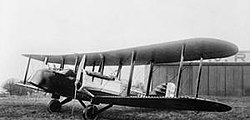Avro 533
| Avro 533 Manchester | |
|---|---|
 Manchester Mk II |
|
| Type: | Bomber , reconnaissance aircraft |
| Design country: | |
| Manufacturer: | |
| First flight: |
December 1918 |
| Number of pieces: |
2 |
The Avro 533 Manchester was one triple-designed as a bomber biplane of the British manufacturer Avro .
General
The twin-engine bomber and photo reconnaissance aircraft Avro 533 presented in 1918 was a consequent further development of the Avro 523 Pike and Avro 529 . The aircraft was created on the basis of a specification by the British Ministry of Aviation , in which the use of the new 7-cylinder radial engines of the type ABC Dragonfly I with an output of 238.62 kW (324.44 hp) was required for such a machine.
The first prototype was completed in October 1918, but was immediately converted back to the highly compressed, water-cooled 300 hp Siddeley Puma engines, as the ABC Dragonfly could not initially be delivered due to manufacturing problems, but Avro wanted to carry out test flights. In November 1918 the “Pumas” reached the Avro factory - the prototype equipped with these engines was named Avro 533A Manchester Mk.II - the first flights took place in December.
Avro left the machine to various air force units for test flights until September 1919, after which it was planned to equip the aircraft with Napier Lion engines, but installation was no longer carried out.
The second machine was equipped in December 1918 with the Dragonfly engines and received the designation Avro 533A Manchester Mk.I . In addition to the different engines, the two models differed in a slightly reduced area for the lower wings of the Mk.I and in the design of the vertical stabilizer. After extensive testing at Avro, the Mk.I was flown to Martlesham for troop tests and remained there until October 1919.
The flight performance of the Manchester was remarkable despite the relatively low engine power; With the relatively large aircraft even loops were possible.
After the end of the First World War in November 1918, the British Air Force no longer needed a bomber. Therefore, a third prototype, called the Avro 533A Manchester Mk.III , which was intended to be equipped with 400 hp (406 hp) Liberty engines, was no longer completely built.
Incidentally, none of the prototypes was equipped with an armament; in the case of series production, a single machine gun was planned for the bombardier and rear gunner positions.
construction
The Avro 533 Manchester was a three-legged braced biplane with the same length upper and lower wings. The wings were wooden structures covered with fabric with ailerons on all four surfaces as well as aerodynamic lift aids attached to the top of the upper surfaces, called in the original "Park bench" (park bench).
The hull also consisted of a fabric-covered wooden structure.
The rigid main landing gear consisted of two individually attached wheels, the tail landing gear of a rigid tail spur.
The machine had three open cockpits - the pilot's cockpit was slightly in front of the leading edge of the upper wing, behind it was the space for the rear gunner, the space for the observer / bombardier was in the bow.
Technical specifications
| Parameter | Data (Avro 533 Mk.I) | Data (Avro 533 Mk.II) |
|---|---|---|
| crew | 3 | |
| length | 11.28 m | |
| height | 3.81 m | |
| Wingspan | 18.29 m | |
| Wing area | 75.56 m² | 75.93 m² |
| Empty mass | 2217 kg | 2075 kg |
| Max. Takeoff mass | 3352 kg | 3247 kg |
| drive | two 7-cylinder radial engines ABC Dragonfly I each with 238.62 kW (324.44 PS) |
two 6-cylinder in-line Siddeley Puma engines , each with 223.71 kW (304.16 PS) |
| Top speed | 180 km / h | 192 km / h |
| Service ceiling | 5800 m | 5180 m |
| Rise time | 14.20 min at an altitude of 3050 m | 16.30 min at an altitude of 3050 m |
| Flight duration | approx. 5.45 h | approx. 3.45 h |
See also
literature
- EA Harlin, GA Jenks: Avro. An Aircraft Album. Ian Allen, Shepperton 1973, ISBN 978-0-7110-0342-2 . *
- Harry Holmes: Avro: The History of an Aircraft Company. The Crowood Press, Wiltshire 2004, ISBN 1-86126-651-0 .
- Aubrey J. Jackson: Avro Aircraft since 1908. Putnam, London 1965, ISBN 0-85177-797-X .
- Francis K. Mason: The British Bomber since 1914. Putnam, London 1994, ISBN 0-85177-861-5 .
- Michael JH Taylor (Ed.): Jane's Fighting Aircraft of World War I. Studio Editions, London 1990, ISBN 0-517-03376-3 .
